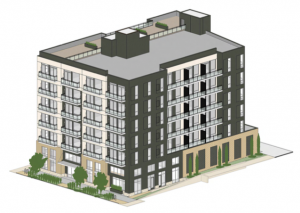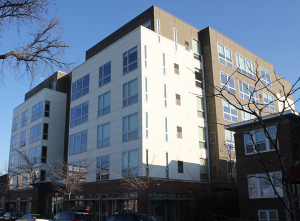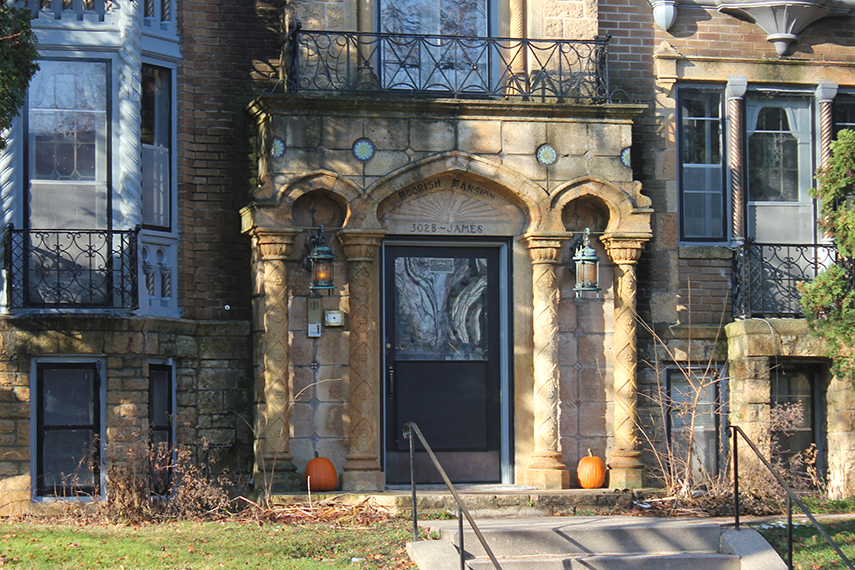At PastForward, the National Trust for Historic Preservation’s annual preservation conference, attendees were asked to consider the National Trust’s crowd-sourced vision for the next 50 years of preservation. One individual suggested that preservationists need to work with architects to help them design future landmarks. This comment reminded me of a colleague’s somewhat tongue-in-cheek belief that all buildings should be given landmark status upon completion, allowing modifications only when vetted by preservation commissions. Both of these ideas depend upon the concept that everything designed and built today is (or should be) worthy of future preservation.

I returned from PastForward to an email from my neighborhood association alerting us to yet another six-story apartment building proposed for south Minneapolis (see image). The development company claims in their letter that they “share a common goal with the neighborhood in that [they] intend to create a project that is thoughtfully laid out, visually appealing, and respectful of small area plan guidelines.”
The Twin Cities needs high-density development for all market rates. According to a recent Star Tribune article, the average vacancy rate within the 13-county metro is at 2.5 percent (“Apartment demand, rents stay strong in Twin Cities” by Jim Buchta, November 8, 2016). Given my knowledge of the developers and the proposed location near the Uptown neighborhood, this development will be but a drop in the flood of luxury rentals currently under construction. (Although the developer claims the building will be “market rate,” I suspect anything near Uptown is luxury compared to the Twin Cities market as a whole.)
Minneapolis has a rich tradition in multifamily residential design. During the high-density construction boom of the early 1900s, nearly 1,000 apartment houses were built throughout the city. Today, the low-rise masonry buildings that remain from that time are in high rental demand (see images, below). In my early days as a Minneapolitan, I sought them out for their hardwood floors and historic character. While most are of similar height, scale, and layout, their exterior and interior architectural character differs from building to building. Several of the early twentieth century apartment buildings are now landmarked locally or listed on the National Register of Historic Places.

Once upon a time, I wanted to be an architect. I received a Bachelor of Architecture degree despite my fierce passion for working with historic buildings. For every project we were told to start with a tabula rasa (or “blank slate”), I insisted on leaving the existing buildings on site and designing around, through, and with them. Today, I still consider myself a preservationist with futuristic tendencies. I love to see the layers of history in the architecture of urban environments. I love to see excellent contemporary architectural design wherever it is, urban or rural. Though I am not an architect, I became an Associate Member of the AIA so I could continue to be connected to a world that promises innovative building technology, creative aesthetic, and the future of place.

Looking at that axonometric view of the new design proposed for my neighborhood, I wonder whether an apartment building of that caliber will ever be worthy of landmark status. From the developer’s letter: “The building height and street front elevation will complement the scale and massing of the nearby recently constructed residential buildings on Holmes Avenue.” I’ve heard mimicry is the greatest form of flattery (see image of referenced development). “The upper floors of the building will be clad in stucco and lap cementitious siding with metal panel accents and cornice.” There’s nothing that makes my design-passionate heart leap like the talk of cementitious siding with metal accents (/sarcasm).
I don’t mean to demean the proposed design for the Holmes Avenue Apartments (which will someday have a perfectly unordinary Scandinavian name). The building will certainly meet the needs for the privileged community to which it caters. But will it be landmark worthy in fifty years? Will it, and the myriad other luxury apartment houses going up in the City of Minneapolis (and the Twin City region in general), even stand for fifty years? (See other contemporary development in the neighborhood, below.) My husband reminds me that the ubiquitous Modern Mansard roof apartment houses of the 1970s are now forty-plus years old, somehow still standing, and are now being studied for landmark status, despite my opinions of their excellence (or lack thereof).

So I return to the recommendation proposed at PastForward for preservationists to work with architects to design future landmarks. Most of the architects I know (i.e., not the “Starchitects” of Frank Gehry, Norman Foster, or Zaha Hadid fame) are designing to solely meet the needs of their clients. While they obviously consider the life-cycle of the materials, the functionality of the spaces, and the overall aesthetic of the finished result, I don’t believe they actively consider whether their designs will be worthy of landmark status. And that’s okay.
Architects should design for contemporary excellence, keeping the past, present, and future community in mind rather than the egotistical stroking landmark status might bestow upon them in fifty years. Excellent design considers the architectural context within which a building is placed. It considers the physical, environmental, and emotional needs of current and future inhabitants and the neighborhood as a whole. It considers the environmental sustainability afforded by the building’s materials, systems, and amenities. A truly excellent design will be worthy of landmark status in the future not only because it is a physical record of its time, place, and use, but because it will have an authentic, meaningful, and significant impact on the community for which it was built. While I suspect the new apartments in my neighborhood will never reach that potential, I do believe that architects can and must design with positive community impact as the ultimate goal. If they can achieve that, perhaps landmark status will follow.


May 15, 2017 at 9:30 pm
Barbara – I, too, think that architects should have an eye on the future in designing buildings. How might they make different design choices if buildings were required to be standing and useful 200-300 years in the future? Investing in the construction of a building requires a significant investment in natural and human resources. We ought to make all of those resources count for as long as possible. If it takes considering landmark status to stroke an architect’s ego enough to design for the long term, I think it should be encouraged.
May 16, 2017 at 11:02 am
Thanks for the comment, Mary! When I was an architecture student a million moons ago, I recall seeing a picture of Frank Lloyd Wright looking out over one of his creations and thinking that could be any one of us some day. That sort of ego was encouraged. The idea of a building lasting 200-300 years, however, was only suggested through the study of architectural history. And, unfortunately, I have heard more and more architecture schools are reducing requirements for the study of architectural history. Sustainability coursework, however, has taken a prominent place. Somehow we need to intertwine those concepts.